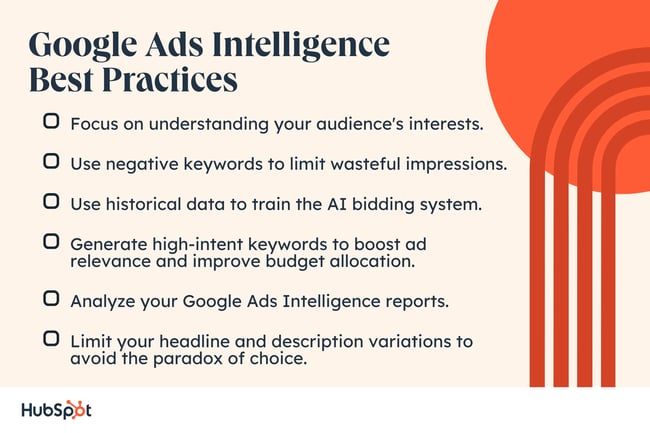Google Ads is the world’s largest PPC advertising platform. If used effectively, you can generate significant profit for companies. But wrapping your head around it can be hard.
Google Ads is the world’s largest PPC advertising platform. If used effectively, you can generate significant profit for companies. But wrapping your head around it can be hard.
Google Ads requires a lot of testing and experimentation. Or, at least, it did until now. Google Ads has recently launched a conversational experience for advertisers, which lets users create their ads by using text prompts.
However, Google Ads Intelligence, as it’s broadly known, offers way more than just being an interactive campaign builder.
In this post, I explain what Google Ads Intelligence is, the key features it includes, and Google Ads AI best practices.
Table of Contents
- What is Google Ads Intelligence?
- When did Google roll out AI for ads?
- AI Features in Google Ads
- Best Practices When Using Google Ads Intelligence
What is Google Ads Intelligence?
Google Ads Intelligence is an umbrella term for a set of AI-powered tools Google launched to help advertisers create effective campaigns. Their motto is to help businesses reach the right people with the right creative at the right cost.
While, in recent years, it already included some intelligent features like Smart Bidding, it will now be helpful at a whole new level.
Advertisers will be able to use a conversational interface, which will guide them through the entire ad design creation process, from suggesting headlines to selecting the right keywords, writing copy, and creating imagery.
Just like in the case of ChatGPT, advertisers can use text prompts to communicate to Google Ads AI what content and visuals they’d like to feature in their ad — or set of ads.
The conversational bot will keep generating text and images until the person or team launching the ad is happy with the result.
Google assures creators that they’ll always use unique images. This avoids situations where two completely different businesses have the same creatives. The conversational AI experience is available for Google’s Performance Max users.
When did Google roll out AI for ads?
Performance Max was the first-ever AI-powered campaign solution from Google.
It premiered in its experimental form in 2021 and was rolled out for a number of Alphabet, Inc. platforms — not only Google ads inventory but also Gmail, Google Maps, YouTube, and Search.
In a blog post from late 2023, Google said that the reason why they decided to launch it was to let their advertisers stay on top of changing market conditions.
They realized that businesses, both small and large, would need access to smart engines, i.e., ones that would allow them to quickly adapt to new consumer trends.
What we see today in Google Ads Intelligence is the result of user feedback that the company collected over the years. It gave birth to features like search themes, asset group reporting, and campaign-level brand exclusions.
The newly added features were introduced at the Google Marketing Live event in May 2023. As mentioned earlier, these will first be available to U.S. customers who use Performance Max.
Google hopes that the upgrades they’ve made to Google Ads Intelligence will help marketers create assets that perform well, contributing to business growth.
AI Features in Google Ads
Broad Match
Broad match helps advertisers automatically extend their ads’ reach by having it shown to people who searched not only for the exact term but also used synonyms and contextually connected keywords.
As in the example below, someone who taps in “carb-free foods” could see an ad launched for the term “low-carb diet plan,” as it fits the searcher’s overall intent.
Marketers who use this feature can shorten the time needed to research additional keywords and manually verify their intent.
They can also use the suggested phrase lists to understand what phrases their ideal customers tap into Google to find products and services like theirs.
Broad match can be particularly powerful if used in sync with smart bidding, which I discuss next.
Smart Bidding
Google uses automated bidding strategies to help advertisers optimize conversions on their PPC campaigns.
Every single auction gets a precise bid, which either drives more conversions or lowers the cost. It uses machine learning to analyze data from all previous campaigns to achieve the best results.
So, even if you’re starting a new campaign and don’t have any data available, it will use findings from the previous campaigns to improve the performance of your new ads.
Here is what you expect, thanks to smart bidding:
- Improving your chances of meeting your business goals by selecting the right bidding strategies, whether it’s increasing sales or leads or boosting your profit margins.
- Real-time bid optimization. You can set more specific bids for each auction that will be tailored to the user’s search context.
- Query-level performance modeling. Some keywords lack data, but because Smart bidding relies on search queries’ performance, it can still accurately bid on keywords that have no or little performance history.
- More contextual signals. Many factors can influence a person to either click or not click on an ad, for example, a device, location, or time of day.
- On top of these, Smart bidding also takes into account language, operating system, browser, etc. It analyzes data to figure out which factor combination has the biggest impact on conversion. It uses the results to boost ad performance in real time.
- Continuous learning. Google’s algorithms learn constantly. Smart bidding reviews your ads performance data alongside market trends, competitive landscape, seasonality, etc., to refine the bidding strategy and maintain good campaign effectiveness.
Ad Strength
As part of building out the Google Ads Intelligence experience, Google has also introduced a feature called Responsive Search Ads (RSA).
Marketers can provide up to 15 headlines and four descriptions for a single ad and have a machine learning engine analyze its strength value and mark these variations as “Incomplete,” “Poor,” “Average,” “Good,” or “Excellent.”
This way, advertisers can decide which version to go with to boost the campaign’s performance.
Conversational Experience in Google Ads
It’s a tool that uses a chat to speed up the process of search campaign creation by supporting your expertise with Google AI.
It’s called ‘conversational experience’ for a reason — since it’s able to understand human language, you can communicate with it freely, just like you would with a real person.
To get started, you need to enter your landing page’s URL, and it will automatically generate a short description of your business, which you can then edit to your liking.
It will also provide you with headlines, suggest images and site links, and generate the right keywords.
All you have to do is accept or reject the suggestions. Here are a few tips that will help you get the best results:
- Use natural language in your prompts.
- Keep them short and clear.
- Make sure that your campaigns follow Google Ads’ policies.
- If you’re unhappy with the result, try to modify your prompt.
Automatically Created Visual Assets
There’s a lot of hype around conversational AI’s capability to turn text into visuals. Google Ads’ text-to-image ability is no different.
If you provide a text prompt in the context of your ad, it can generate fitting visuals. In the image below, you can see some suggestions from Google’s image library:
What if you feel that the images are a bit too generic for your taste?
You can ask Google to make edits — for example, tweak the background or even select a single element from the image to create a new one.
Here’s an example of how a group stock photo can be turned into a summer or Christmas photo of an individual:
Optimized Targeting
Perhaps the most impactful AI feature in boosting ROI, optimized targeting lets marketers enter a whole other level of detail in selecting audiences.
Instead of relying only on the audiences you’ve already established, this Google Ads Intelligence feature also dives into its data to suggest new lead segments.
How does it work?
Google makes suggestions based on what you already know about the traits of high-conversion lead segments and uses its own data from Google Ads to point you to new ones.
The ability to merge your own information with broader market insights from Google shows just how powerful AI can be in boosting your return on ad spend.
Best Practices When Using Google Ads Intelligence
1. Focus on understanding your target audience’s interests.
Before you start running your ad campaign, you need to gain a good understanding of your target audience’s interests — and that’s exactly what Google Ads Intelligence lets you do.
You can get insights into the types of content and keywords that resonate most with your ideal customers. By analyzing this data and optimizing your ad campaigns accordingly, you can create messaging that truly speaks to their needs and motivations.
This is the approach that Dmitriy Bobriakov, marketing manager at RealEstateU, follows. Bobriakov once worked with an online retailer selling home goods and furniture.
Using Google Ads Intelligence, he discovered their target demographic was very interested in interior design trends and DIY projects.
“Based on this, I recommended refocusing their ad messaging to highlight the stylish, contemporary furniture designs they offered. I also suggested targeting keywords related to interior design themes, like ‘bohemian decor’ and ‘modern farmhouse,’” he says.
What was the result? A 21% decrease in cost-per-click and a 34% increase in conversion rate.
Bobriakov adds that “the key was taking the time to really understand the audience and what motivated them, instead of making assumptions. Google Ads Intelligence provided the insights to make our ads more compelling and effective.”
2. Use negative keywords to limit wasteful impressions.
To maximize your ad spend and get the best results from your campaigns, you need to know which keywords to target and which to ignore.
And the latter is as important as the former. It will help you eliminate searches and, therefore, people who aren’t looking for what you’re selling.
For example, let’s assume you’re running a campaign for a local bakery from Austin that specializes in custom cakes.
While selecting keywords, you might want to go with custom wedding cakes, birthday wedding cakes, bespoke wedding cakes near me, etc.
Exclude keywords like free, how to, cheap, etc., as these are usually associated with people who want to make cakes themselves and have a limited budget.
Joanne Highland, content writer and yoga teacher at Mind is the Master, says that she uses negative keywords to limit wasteful impressions. It allowed her to decrease unnecessary click-through rates by 15%.
3. Use historical data to train the AI bidding system better.
Some of Google Ads’ Intelligence features are already gaining ground, even among advertisers who prefer to manage campaigns manually.
“One such tool is the AI-powered automated bidding, in particular, the Maximize Conversion Value,” says Eliza Fillo, senior digital ads coordinator at Online Optimism.
She says that they were able to use significant amounts of historical data on conversion actions. This allowed the company to train the AI bidding system to better evaluate which users they want to bid higher for, boosting efficiency.
“I would recommend using Google Ads’ AI bidding system if you have historical data and there are multiple actions you’d like a user to take. But, since some of those actions are more valuable than others, when starting off, I recommend monitoring the bidding closely so you can intervene as needed,” Fillo says.

4. Generate high-intent keywords to boost ad relevance and improve budget allocation.
High-conversion phrases are the holy grail in marketing, which is why Google Ads Intelligence’s ability to suggest keywords with a high-purchase-intent holds such huge potential.
Many companies, including Najeeb Ur Rehman’s Digital Auxilius, are now experimenting with Google’s AI within the Keyword Planner feature.
“This ensures that individuals seeking our products or services see our ads, increasing CTR and conversions. Incorporating these high-performing keywords into our ad content improved the ad’s relevance, engagement, and conversion rates,” he said.
Mike Bullen, director at Eurisko, agrees, underlining that “having Google AI’s broad match functionality recommend a tighter number of keywords, based on our seed list, is critical with regards to identifying new trends and keyword opportunities, without losing too much of our budget to irrelevant search terms.”
5. Analyze your Google Ads Intelligence reports regularly.
According to Sai Blackbyrn, CEO of Coach Foundation, it’s key to continuously review insights from Google Ads Intelligence reports and make data-driven optimization decisions.
He says that “the Intelligence reports provide insights into how your ads are performing and opportunities to improve results. For example, the ‘Opportunities’ report showed me that by increasing my CPC bid for one of my top converting keywords by 30%, I could gain an estimated 15% more conversions at a reasonable cost.”
Blackburn adds that he tested the change and ended up gaining closer to 20% more conversions for that specific keyword.
6. Limit your headline and description variations in RSA to avoid the paradox of choice.
As I’ve mentioned earlier, Google Ads Intelligence lets you provide up to 15 headlines and four ad descriptions so you can see performance predictions.
While it might be tempting to use up these up to its limit, Eurisko’s Mike Bullen advises against this.
“We use Google Ads for several clients and have been pushing leads into HubSpot to help close the loop on customer conversions and customer value. We’re very hands-on as an agency, and we balance the Google Automations with our own best practice procedures,” he says.
When asked about how many ad copy variations should be used, Bullen responds: “We test the Google AI against a responsive ad group with only three headlines and two descriptions to see which ad generates the best engagement and conversions.”
These variations can present two or three different directions, so it’s easier to test them out and spot which ones have a higher chance of converting.
This is a very smart way of using the AI feature most effectively. If you were to create 15 or even 10 versions, the differences could be so subtle that you’d face the dilemma of which copy to run.
Using Google Ads Intelligence to Win Over More Clients
Google Ads Intelligence is making the work of advertisers much easier and more effective. It’s particularly a game-changer for those who aren’t performance marketing pros.
Thanks to its data analytics capabilities and access to global data, it’s able to point to people who are responsive to your campaigns, as well as expand to new audiences that have a high probability of converting.
This significantly enhances your profit generation potential, helping you allocate your budget more efficiently in the long run.
What’s great about Google Ads Intelligence is that, since it uses Natural Language Processing, it’s able to understand human speech.
This means you can communicate with it like you would with a real person and treat it as your personal assistant.
Ultimately, all the decisions regarding the ads are still yours.
![]()



![Download Now: Ultimate Google Ads PPC Guide [Free Kit]](https://no-cache.hubspot.com/cta/default/53/fbcf2b0b-3c92-4b5b-aee9-f9baf59d9721.png)
